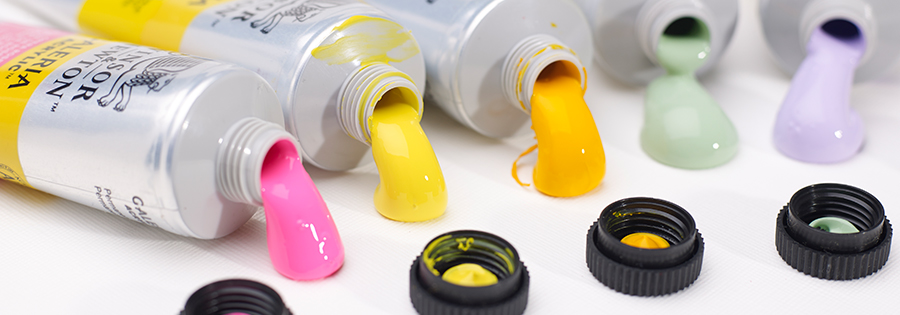Choosing your Acrylic Paints

Combining different acrylic colours
Winsor & Newton Professional and Galeria colours can be freely intermixed. However, it is possible that different brands of acrylics may show some incompatibility and mixes should be tested first. Any reaction will show immediately on the palette as thickening.
Permanence
Most artists like to be sure that their colours are permanent. Fortunately, the 20th century has seen enormous improvements in the lightfastness of colours. All Winsor & Newton colours rated AA or A are recommended as permanent for artists' use. Permanence ratings are on the product labels and our colour charts.
Underpainting for oil colour
Acrylics can be used for underpainting on a stretched canvas provided the paint film remains thin. Thicker underpainting layers are possible on boards.
Basic Palettes
Your initial palette should provide a wide colour spectrum and should have a good balance between transparent and opaque colours and between strong tinting and weaker tinting colours. Permanent colours are always desirable and the main palette should ideally be low in price. The common practice is to maintain a broad palette of about twelve colours and add to it for specific requirements.
Here are the recommended palettes:
Winsor & Newton Professional Acrylic Colour | Galeria Flow Formula Acrylic Colour |
|
|
|
|
Colour mixing - the six colour system
Restricted palettes are used by both beginners and serious painters to develop their understanding and use of colour. The six colour system uses two reds, two yellows and two blues as a 'primary' palette.
This provides both a blue shade red and a yellow shade red for example, which will ensure clean violets and clean oranges from your palette. The additional colours recommended in the basic palette introduce a wider range of tones and greater variation in opacity and tinting strength.
Winsor & Newton Professional Acrylic Colour | Galeria Flow Formula Acrylic Colour |
|
|
Additional colours for particular techniques:
When choosing new colours, an excellent investment is a hand painted colour chart of the range. For a small price, you'll be able to see all the colours in graded washes, helping you to make the right choice before buying new tubes.
Landscape Painting
New or different colours can really broaden your painting vocabulary. For landscapes, yellows, blues, greens and earth colours are always useful. Try some texture gels too, rocks and sand work really well with them.
.jpg)
Landscape Colours |
|
Portrait Painting
Portraiture needs that spark of life and character; clean, crisp colour mixtures and tones will achieve these. Pinks, violets and earth colours will make some of the subtle tones required for portraits.
Portrait Colours |
|
Secondary Colours
In addition to the bright secondary colours you will achieve from your basic palette, single pigment 'secondaries' are important, eg. Phthalo Green Blue Shade can make brighter mixes than if you use a green mixed from a blue and yellow.
Useful Secondary Colours |
|
Glazing
Transparent colours are used as thin tinting films. An overall glaze at the end of a picture unifies the image. Glazing can also be used throughout the painting to produce delicate colour effects and depth. Often a thin wash is required, this is best done with Acrylic Fluid Gloss Medium and a touch of water. The extra gloss also improves the depth of colour.
Glazing Colours |
|
Abstract Painting
Abstract colour areas benefit from using opaque colours. They give flat, smooth finishes, covering underlayers and not showing brush marks.
Useful Abstract Colours |
|
Scumbling
Scumbling also uses the opaque colours, very slightly diluted and scrubbed on briskly to achieve a scumbled glaze.
Scumbling Colours |
|
High key (bright) colour
These are generally the colours with high tinting strength. High key paintings are often made 'alla prima' (at first attempt), using colour straight from the tube.
High Key Colours |
|
Low key (subdued) colours
These can be tints (colour plus white) or shades (colour plus black) but can also include earths and other naturally low - tinting strength colours.
Low Key Colours |
|
Staining
Acrylics are ideal for this technique because they do not sink like oil colours. The most intense effects will be achieved with the opaque colours in addition to phthalo colours and Dioxazine Purple. Acrylic Flow Improver will help the staining effect by driving the pigment into the canvas.
Staining Colours |
|
Palettes for Acrylic Painting
For painters who find acrylics dry too quickly, Acrylics Palettes are available which keep the colours usable for days. This is particularly useful if you are painting every day, as they save you throwing away colour.
Disposable and conventional palettes can also be used for acrylics of course but remember to clean the melamine surface before the paint dries!













